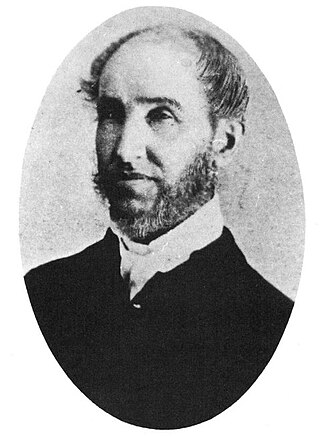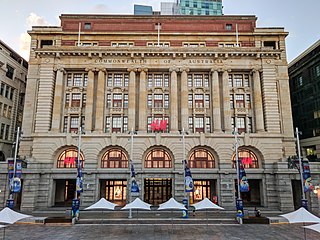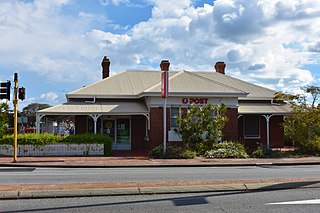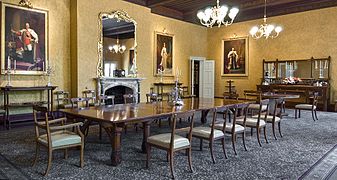
York is the oldest inland town in Western Australia, situated on the Avon River, 97 kilometres (60 mi) east of Perth in the Wheatbelt, on Ballardong Nyoongar land, and is the seat of the Shire of York.

Parliament House, Perth is located on Harvest Terrace in West Perth, Western Australia. It is the home of the Parliament of Western Australia, including the Legislative Council and Legislative Assembly.

Government House is the heritage-listed vice-regal residence of the governor of New South Wales. It is located on Conservatorium Road in the Sydney central business district, adjacent to the Royal Botanic Garden, and is situated south of the Sydney Opera House, overlooking Sydney Harbour. Constructed between 1837 and 1843, the property has been the primary vice-regal residence of the Governor since Sir George Gipps, except for two brief periods; the first between 1901 and 1914, when the property was leased to the Commonwealth of Australia as the residence of the Governor-General of Australia, and the second from 1996 to 2011.

Government House, Hobart, is the home and official residence of the governor of Tasmania, Australia. The palatial house is located on Lower Domain Road in the Queens Domain, near the Royal Tasmanian Botanical Gardens. There have been three Government Houses, all in Hobart.

William Mitchell was a Church of England priest who was the second ordained person, after Louis Giustiniani, to provide religious services in the Swan Valley area of the Swan River Colony. He worked in the Swan Parish for over 20 years before moving to Perth to take up a position working with convicts and prisoners in the Perth Gaol in Beaufort Street.

The Perth Gaol was a gaol built in Perth, the state capital of Western Australia, between 1854 and 1856 to house convicts and other prisoners. It is located just west of Beaufort Street.

The Art Gallery of Western Australia (AGWA) is a public art gallery that is part of the Perth Cultural Centre, in Perth. It is located near the Western Australian Museum and State Library of Western Australia and is supported and managed by the Department of Local Government, Sport and Cultural Industries of the Government of Western Australia. The current gallery main building opened in 1979. It is linked to the old court house – The Centenary Galleries.

Governor Stirling Senior High School is a public co-educational partially selective high day school, located in Woodbridge, a north-eastern suburb of Perth, Western Australia. The school provides both a vocational and tertiary entrance education for students from Year 7 to Year 12.

The Old Court House is the first court building constructed in Perth, Western Australia. It is located between Stirling Gardens and Supreme Court Gardens, off Barrack Street, adjacent to the Supreme Court building. It is a single-storey cream rendered building, with a wooden shingle roof.

Wesley Church is a Uniting Church in Perth, Western Australia, located at the corner of William Street and Hay Street. It is one of the oldest church buildings and one of few remaining 19th-century colonial buildings in the City of Perth.

The 1910 Perth Technical School building is located at 137 St Georges Terrace, Perth, Western Australia, adjacent to the Old Perth Boys School building, which had served as part of the school's former temporary premises since opening of classes there on 16 May 1900.

The General Post Office is a heritage landmark building in Perth, Western Australia. Located on the western side of Forrest Place in the city's central business district, its imposing stone facade is in the Beaux-Arts style. The building was completed in 1923 after almost a decade of construction, which was protracted by World War I and the resulting shortages of construction materials. At the time of its opening, it was the largest building in Perth.
Henry Willey Reveley (1788–1875) was a civil engineer responsible for the earliest public works at the Swan River Colony, the foundation of the state of Western Australia.
Hillson Beasley was an English-trained architect who relocated to Australia, executing his major buildings in Melbourne (1886–96) and Perth (1896–1917). In his later career he was the Principal Architect of Western Australia's Public Works Department and designed many notable public buildings, including the Government House ballroom (1899), Parliament House, Perth (1900-1904), Fremantle Post Office (1907) and the old Perth Technical School (1910).

Trinity Church is a Uniting church located at 72 St Georges Terrace in Perth, Western Australia. Commenced in 1893, the former Congregational church is one of the oldest church buildings in the City of Perth, and one of the few remaining 19th-century colonial buildings in the city.
The 1829 town plan of Perth, Western Australia was an elongated grid pattern that reflected the city planning principles of the day, and likely drew inspiration from colonial Williamsburg (1699) and the Edinburgh "new town" (1768). The plan expressed an enlightenment conception of the town as the seat of civic power within a large and productive agricultural hinterland. Contrary to these ideals, the development of an economy based around mineral resources would make Perth the commercial center of the colony, and later, metropolitan region with a layout that has remained relatively unchanged to the present day.

Stirling Terrace is the main street of Toodyay, Western Australia, originally called New Road until 1905.

South Perth Post Office is a heritage-listed post office at 103 Mill Point Road, South Perth, Western Australia, Australia. It was added to the Australian Commonwealth Heritage List on 8 November 2011.

Claremont Post Office is a heritage-listed post office at Bayview Terrace, Claremont, Western Australia, Australia. It was added to the Australian Commonwealth Heritage List on 22 June 2004.

Northam Post Office is a heritage-listed post office at 239-243 Fitzgerald Street, Northam, Western Australia, Australia. It was added to the Australian Commonwealth Heritage List on 22 June 2004.




























